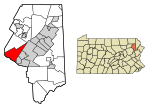Lewis Creek (Susquehanna River tributary)
Lewis Creek is a tributary of the Susquehanna River in Luzerne County, Pennsylvania, in the United States. It is approximately 1.8 miles (2.9 km) long and flows through Exeter Township. The watershed of the creek has an area of 1.64 square miles (4.2 km2). The creek is not designated as impaired and has typical water chemistry for a stream of its geology and land use. Rock formations in its watershed include the Catskill Formation. Most of the watershed of Lewis Creek is on forested land. However, agricultural and residential land are also present in some areas. A plaster and clover mill historically operated on the creek. A stream inventory was carried out on Lewis Creek in August 2005. It is designated as a Coldwater Fishery and a Migratory Fishery, as well as Class A Wild Trout Waters. A total of 13 species, including brook trout and brown trout, inhabit the creek.
Excerpt from the Wikipedia article Lewis Creek (Susquehanna River tributary) (License: CC BY-SA 3.0, Authors).Lewis Creek (Susquehanna River tributary)
Boatlaunch Path, Exeter Township
Geographical coordinates (GPS) Address Nearby Places Show on map
Geographical coordinates (GPS)
| Latitude | Longitude |
|---|---|
| N 41.38818 ° | E -75.82315 ° |
Address
Boatlaunch Path
Boatlaunch Path
18653 Exeter Township
Pennsylvania, United States
Open on Google Maps




